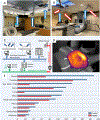One Year of Clinic-Wide Cherenkov Imaging for Discovery of Quality Improvement Opportunities in Radiation Therapy
- PMID: 35777728
- PMCID: PMC10984217
- DOI: 10.1016/j.prro.2022.06.009
One Year of Clinic-Wide Cherenkov Imaging for Discovery of Quality Improvement Opportunities in Radiation Therapy
Abstract
Purpose: Cherenkov imaging is clinically available as a radiation therapy treatment verification tool. The aim of this work was to discover the benefits of always-on Cherenkov imaging as a novel incident detection and quality improvement system through review of all imaging at our center.
Methods and materials: Multicamera Cherenkov imaging systems were permanently installed in 3 treatment bunkers, imaging continuously over a year. Images were acquired as part of normal treatment procedures and reviewed for potential treatment delivery anomalies.
Results: In total, 622 unique patients were evaluated for this study. We identified 9 patients with treatment anomalies occurring over their course of treatment, which were only detected with Cherenkov imaging. Categorizing each event indicated issues arising in simulation, planning, pretreatment review, and treatment delivery, and none of the incidents were detected before this review by conventional measures. The incidents identified in this study included dose to unintended areas in planning, dose to unintended areas due to positioning at treatment, and nonideal bolus placement during setup.
Conclusions: Cherenkov imaging was shown to provide a unique method of detecting radiation therapy incidents that would have otherwise gone undetected. Although none of the events detected in this study reached the threshold of reporting, they identified opportunities for practice improvement and demonstrated added value of Cherenkov imaging in quality assurance programs.
Copyright © 2022 American Society for Radiation Oncology. Published by Elsevier Inc. All rights reserved.
Conflict of interest statement
Conflict of Interest Statement for All Authors:
DAA, and SMD are consultants of, PB and MJ are employees of, and BWP is president and co-founder of, and LAJ has financial interests in, DoseOptics, LLC.
Figures





References
Publication types
MeSH terms
Grants and funding
LinkOut - more resources
Full Text Sources

